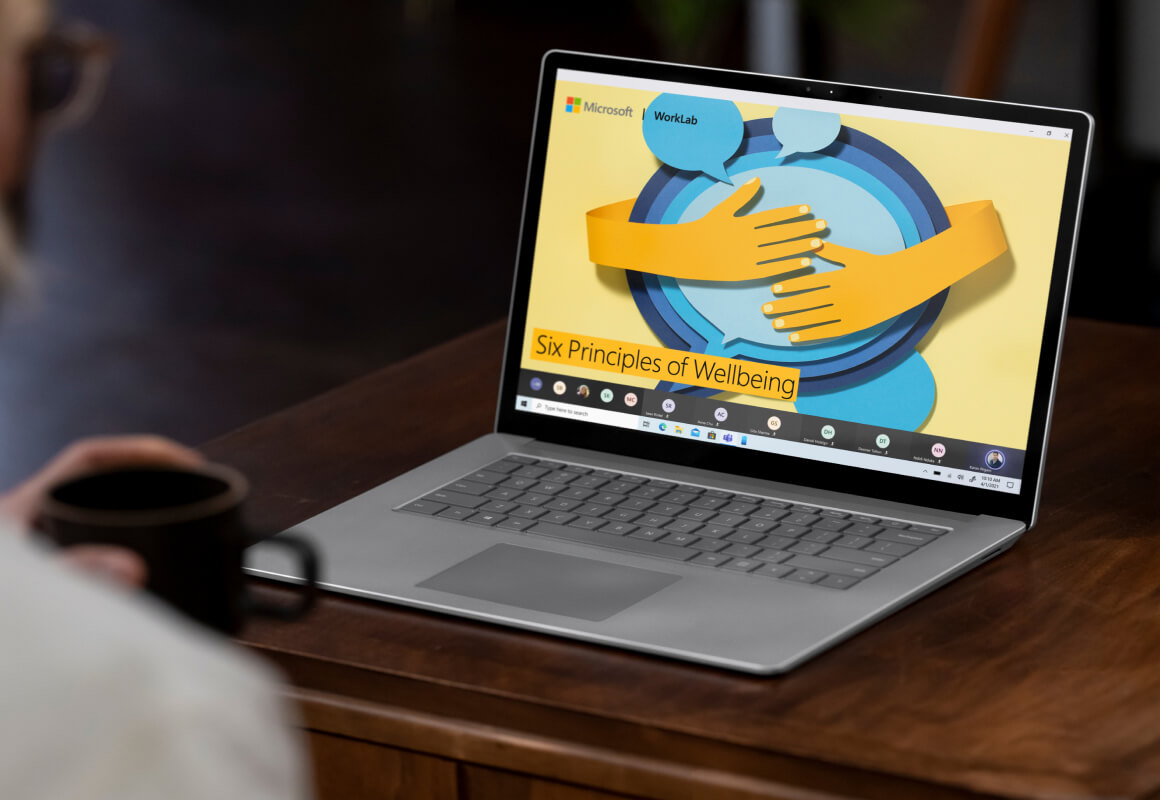O ver the last 12 months , we’ve learned a lot about working remotely. One of the things that I didn’t expect at the outset of the pandemic was how much of a challenge employee wellbeing would be.
Just six months into the pandemic, 30 percent of frontline and information workers were already reporting that they felt increased burnout at work. And data from Microsoft Teams users around the world signaled that many of us were working harder and longer: We saw a 48 percent increase in Teams chats per person overall and a 69 percent increase in Teams chats per person after-hours. Now, as hybrid work takes hold, norms are shifting again. But one thing shouldn’t change: making employee wellbeing a priority.
My leadership team and I are closely studying how work is changing, and we recently used that research, along with input from the team, to come up with six wellbeing principles to help guide us as we navigate a hybrid work future. While they’re not the definitive word on employee wellbeing, I wanted to share them in hopes that they’ll be helpful to others.
In many ways, what mattered the most to my folks wasn’t so much what I said but the fact that I said anything at all. People heard that their wellbeing was important. That they can and should say “no.” And that they should protect the boundaries between work and the rest of their lives. These common-sense principles set a tone that I believe is not only more constructive for everyone on the team but will ultimately lead to greater success. Because our data shows that happier, healthier people also have greater impact.
“Our data shows that happier, healthier people also have greater impact.”
1. Make OKRs your friend
Wellbeing means all of us prioritizing our time and managing our energy, whether we’re working remotely or in-person. But it’s tougher to read the expectations of our colleagues and communicate our own priorities when we’re apart, which can lead to the habit of responding to every interruption as if it’s the most urgent need.
By embracing a framework that ties together clear objectives and key results (OKRs), you’re creating a personal framework that makes clear to yourself and others which work is most important. With this framework in place, you have a filter that empowers you to say “no” more often (which can also mean “not right now”). You also have a tool to help you achieve balance. If you add a new KR mid-quarter, you can shift out another to ensure you’re maintaining equilibrium.
2. Get comfortable with imperfection
In the fast-paced, highly uncertain environment of our current moment, we need to balance striving for perfection with speed and agility. Sometimes “good enough” is, well, good enough. And sometimes it’s not.
To be crystal clear, this is not about lowering the quality threshold for customers. It’s about managing priorities, energy, and expectations for each step along the path toward an outcome. Ask yourself, “Does this need to be good, better, or best?” And encourage your team to discuss it. Champion marathoners don’t sprint at their top speed for 26.2 miles. They manage their pace strategically along the way.
3. Own your boundaries
Wellbeing is both an individual and a team sport. Everyone’s individual circumstances are unique—from caring for a sick parent to juggling the demands of remote learning to struggling with racial injustice. Each of us needs to define our boundaries based on what we can and can’t do—and own them.
We’ve learned so much over the past year.

We’ve learned so much over the past year. Download a deck featuring these six lessons to guide your teams into the new world of hybrid work.
In practice, this means deciding what time you start work, deciding what time you finish work, and sticking to those commitments while communicating them to your team, whether you’re working remotely or in person. Technology can be your friend here. For example, set your status message in Teams to indicate when you’re prioritizing family time. When we all own and respect boundaries, we create a culture of mutual support that promotes everyone’s wellbeing.
“Culture starts at the top, and leaders must be exemplary practitioners of empathy.”
4. Plan meetings with purpose
Meeting bloat is one of remote work’s most counterproductive trends, though the reasons for it aren’t hard to understand. Without well-defined ways to indicate progress and participation, showing up to a meeting has become the signal of doing work. It’s the 21st-century version of punching the clock. This helps neither employees nor employers.
Organizations can undercut this expectation—and the drain on wellbeing that comes from too many meetings—by fostering a meeting culture centered on preparation and purpose. First ask the most basic question: “Do you have to have this meeting? No, really, do you have to?”
If the answer is yes, determine whether the meeting is to disclose, discuss, or decide. Invite only the people who truly need to be there, share the agenda in advance, and prevent FOMO among those not invited by implementing a robust practice of note-taking and note-publishing. Encourage people to review the meeting recording and transcript when they need to catch up. Help people feel that the best meeting out there is the one they didn’t have to attend.
5. Follow the science
As the inaugural members of the world’s first truly digital workforce, we are all creating the future of work together. We are defining norms, habits, and best practices. This privilege carries a responsibility and presents an opportunity: Rather than defaulting to assumptions grounded in conventional wisdom, let’s use this moment to let science guide us.
For instance, science tells us what the world’s best athletes have known for years: Peak performance requires cycles of rest and recovery. More and longer hours don’t equal higher impact. Create a culture where taking breaks is a mark of intelligence, not of laziness. Embrace time outside to help rejuvenate. Wellbeing isn’t a set of slogans. It’s best practices informed by evidence.
6. Lead with empathy
We are all of us. Culture starts at the top, and leaders must be exemplary practitioners of empathy—the most vocal, visible advocates for wellbeing. This creates the permission structure for everyone in the organization to put wellbeing first.
If ever there were a time to give one other grace, it is now. Listen and lead with empathy in every interaction. Be vulnerable. Help ensure that the quietest voices are heard. Make space for fun. Make space for moments of sadness, and moments of joy. Together, we create the culture.

